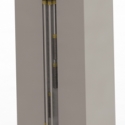Your single point of reference for all your Geotechnical Inquiries
BOR-EX - Rod-Type Borehole Extensometer
The BOR-EX allows for measurements of precise longitudinal dis-placements in rock, soil and concrete structures. Typically it is used for monitoring settlement in foundations, subsidence above tunnels, displacements of retaining structures, and deformations in underground openings.
The borehole extensometer includes anchors, extension rods and a reference head. The anchor is connected to the head of the instrument by extension rods typically placed within a protective sleeve. This sleeve ensures that the rods can move freely and translate all movement of the anchor to the tip of the rod. Movement of the rock or soil mass relative to the head can then be calculated by measuring the displace-ment of the tip of the extension rod to a reference plate lo-cated in the head of the extensometer.
Three head types are available: one that allows mechanical reading only (BOREX-M), one that allows electrical reading only (BOREX-E), and one that allows simultaneous mechani-cal and electrical readings (BOREX-E/M). The mechanical reading is performed with a depth gauge or with a dial indica-tor, whereas electrical readings are done using vibrating wire or potentiometer sensors.
ANCHORS
Groutable Rebar Anchor: Easy to install, this type of anchor is the preferred type for downward boreholes in rock. Can also be installed upward with a special grouting technique A good contact between the borehole wall and grout is important to ensure that any movement of the surrounding material is transmitted to the anchor. Up to six anchors can be installed in a 3-in (NX) borehole.
Hydraulic Borros-Type Anchor: These anchors are typically used in soils where deep penetration of the prongs is required for good anchorage, for instance in cases where hole squeezing is anticipated. A single acting anchor contains 3 prongs, which are extended into the surrounding soil by means of a hydraulic pump. A double acting anchor has extendable prongs at both top and bottom of the anchor. The prongs, once extended, cannot be retracted. The borehole is generally grouted in place following installation. The installation of this type of anchors requires hydraulic tubing and pump.
EXTENSION RODS
Two types of extension rods are available: fiberglass and stainless steel. Ease and speed of installation are the main benefits of the fiberglass rods. Fiberglass rod extensometers are assembled at our factory and shipped to the site, ready to install. Stainless steel rods are preferable for long extensometers. These rods are supplied in sections and are assembled on site.
PROTECTIVE TUBE
Rods are typically installed in protective tubes to protect them from the injected grout and other confining material. Tubes are supplied in sections for stainless steel rods or, when not pre-assembled, can be shipped in continuous lengths for fiberglass rods.
ROD CENTRALIZER
Rod centralizers may be used to maintain the extension rods in position. They are highly recommended for non-grouted, deep installations.
Roctest Ltd.
680 Birch Street
Saint-Lambert, Quebec
Canada J4P 2N3
Tel: +1 450 465 1113
Toll free: 1 877 762 8378
Fax: +1 450 465 1938
Canada













